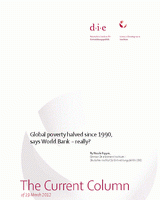Global poverty halved since 1990, says World Bank – really?
Rippin, NicoleThe Current Column (2012)
Bonn: German Development Institute / Deutsches Institut für Entwicklungspolitik (DIE) (The Current Column of 19 March 2012 )
Bonn, 19 March 2012. Have we missed a unique success story? World Bank forecasts in late February suggested that the proportion of poor people in the world shrank by half between 1990 and 2010, and this despite the financial crisis. That means nothing less than that the first and best-known Millennium Development Goal was achieved in 2010, five years ahead of target. We will recall that it was in 2000 that the United Nations approved eight Millennium Development Goals (MDGs), which were to be achieved by 2015. Among the measurable goals is the halving of the proportion of people living in poverty or hunger.
So did the world sleep through a unique cause for celebration? What precisely do the World Bank researchers’ figures say? Measured against a poverty line of USD 1.25 a day, the number of poor people fell from 1.91 billion in 1990 to 1.29 billion in 2008. The claim that the first of the MDGs was probably achieved at global level in 2010 stems entirely from rough initial extrapolations by the World Bank based on the few data sets currently available for 2010.
A Chinese success story
What is more, the success is spread very unevenly among the world’s regions. It is predominantly due to China. Of the 620 million people who have risen above the USD 1.25 poverty line since 1990, 510 million live in China. In other words, if China is excluded, the absolute number of the poor fell by about 110 million – over a period of eighteen years. In sub-Saharan Africa, for example, 386 million people were living in extreme poverty in 2008, some 96 million more than in 1990. Nonetheless, the fact that about 620 million fewer people are living in poverty than eighteen years ago is a good reason to celebrate. But before the champagne corks pop and, rid of our guilty consciences and with a sense of relief, we raise our glasses to the new, general prosperity, a few words need to be addressed to those who cannot help having that uncomfortable feeling of déjà vu.
A case of déjà vu
And in fact the corks popped once before, in April 2007, when, for the first time since the international measurement of poverty began, the number of the world’s poor fell below a billion and the achievement of the first MDG came within reach. However, the joy did not last long. What followed was the “Black Monday“ of poverty alleviation, 26 August 2008, when we awoke to a world in which, at a stroke, 430 million more people were living in poverty than the day before. Not because of some terrible disaster, but because the World Bank, having faced persistent and increasingly outspoken criticism, had reset its poverty line.
The USD 1.08 poverty line in force at that time was based on the average of the national poverty lines of eight of the poorest countries. No need to be an expert to realise that that figure is far too low for the calculation of an international poverty line. The new and current poverty line of USD 1.25 is based on the average of the national poverty lines of the poorest 15 countries. This recalculation and the updating of purchasing power parities, which are meant to guarantee the international comparability of goods and services despite different prices and monetary systems, led to the aforementioned upward adjustment of the poverty figures and revealed that, hitherto, global poverty had been radically underestimated.
The problem with purchasing power parities
Yet the criticism levelled at the World Bank’s figures concerned not only the derivation of the international poverty line, but also the use of purchasing power parities (PPPs). In theory, a PPP dollar will buy the same quantity of goods and services in any country of the world. To ensure the international comparability of its poverty line, the World Bank, too, uses the PPP dollar. This approach is extremely controversial. The calculation of the PPP dollar is based on international baskets of goods that have little to do with the consumption behaviour of the poor. To put it rather polemically: an Indian household might become poor because of a change in the prices of cakes and pastries in Hong Kong. Indeed, the World Bank’s approach is so bizarre that the academics Thomas Pogge and Sanjay Reddy have been inspired to publish a study with the telling title “How Not to Count the Poor“.
A rude awakening?
Against this background, we are bound to feel uneasy about the current optimism. Sooner or later the World Bank will have to react to the growing criticism and correct its figures. Particularly in the light of the recent food price explosion, this could have serious effects. However, as such important data as purchasing power parities are presented only in aggregate form, forecasts are possible to only a very limited degree. The reason given by the World Bank? Purchasing power parities are reliable only in aggregate form because the measurement errors in the various categories of goods and services cancel each other out. But statements of this kind are hardly compatible with what the World Bank would have us believe is the accuracy of its figures. It would be well advised to make its calculations more transparent and to publish not only its figures but also forecasts of the margins within which those figures move. Otherwise, it is to be feared that we will again awake to a world in which the number of poor people has soared overnight. Not because of any real changes, but because the World Bank has again had to make a serious adjustment to its calculations.

